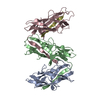+Search query
-Structure paper
| Title | Archaic chaperone-usher pili self-secrete into superelastic zigzag springs. |
|---|---|
| Journal, issue, pages | Nature, Vol. 609, Issue 7926, Page 335-340, Year 2022 |
| Publish date | Jul 19, 2022 |
 Authors Authors | Natalia Pakharukova / Henri Malmi / Minna Tuittila / Tobias Dahlberg / Debnath Ghosal / Yi-Wei Chang / Si Lhyam Myint / Sari Paavilainen / Stefan David Knight / Urpo Lamminmäki / Bernt Eric Uhlin / Magnus Andersson / Grant Jensen / Anton V Zavialov /     |
| PubMed Abstract | Adhesive pili assembled through the chaperone-usher pathway are hair-like appendages that mediate host tissue colonization and biofilm formation of Gram-negative bacteria. Archaic chaperone-usher ...Adhesive pili assembled through the chaperone-usher pathway are hair-like appendages that mediate host tissue colonization and biofilm formation of Gram-negative bacteria. Archaic chaperone-usher pathway pili, the most diverse and widespread chaperone-usher pathway adhesins, are promising vaccine and drug targets owing to their prevalence in the most troublesome multidrug-resistant pathogens. However, their architecture and assembly-secretion process remain unknown. Here, we present the cryo-electron microscopy structure of the prototypical archaic Csu pilus that mediates biofilm formation of Acinetobacter baumannii-a notorious multidrug-resistant nosocomial pathogen. In contrast to the thick helical tubes of the classical type 1 and P pili, archaic pili assemble into an ultrathin zigzag architecture secured by an elegant clinch mechanism. The molecular clinch provides the pilus with high mechanical stability as well as superelasticity, a property observed for the first time, to our knowledge, in biomolecules, while enabling a more economical and faster pilus production. Furthermore, we demonstrate that clinch formation at the cell surface drives pilus secretion through the outer membrane. These findings suggest that clinch-formation inhibitors might represent a new strategy to fight multidrug-resistant bacterial infections. |
 External links External links |  Nature / Nature /  PubMed:35853476 / PubMed:35853476 /  PubMed Central PubMed Central |
| Methods | EM (helical sym.) |
| Resolution | 3.45 Å |
| Structure data | EMDB-14777, PDB-7zl4: |
| Source |
|
 Keywords Keywords |  CELL ADHESION / chaperone-usher pathway / bacterial adhesion / biofilm formation / CELL ADHESION / chaperone-usher pathway / bacterial adhesion / biofilm formation /  Acinetobacter baumannii / Csu pili Acinetobacter baumannii / Csu pili |
 Movie
Movie Controller
Controller Structure viewers
Structure viewers About Yorodumi Papers
About Yorodumi Papers






